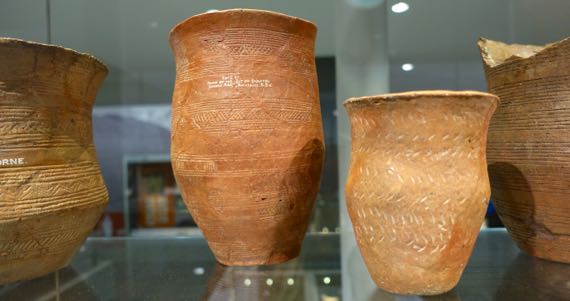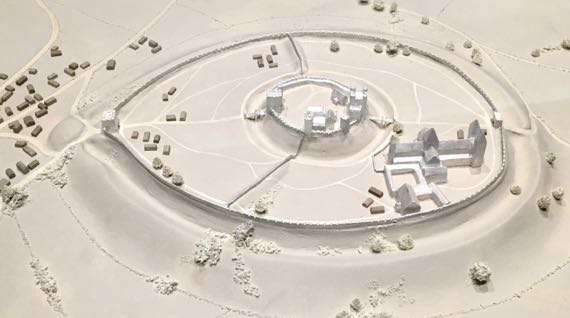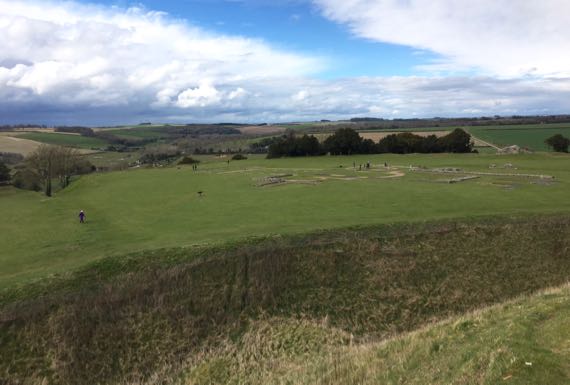
We were slow this morning, jet-lag slow. On the other hand, we did pretty well after we got going. We returned to downtown, parking above the Boston Tea Party mentioned yesterday, and went straight to the Salisbury Museum. The ambitious crew there has been updating the displays and presentation of the institution, and they are doing a fantastic job. We met two fellows from here last year, and so the SM was tops on our list for this trip. Unfortunately, our friend is away on leave, but he kindly left our names at Reception, so we breezed in. People can be so nice! I loved their new-as-of-2014 Wessex Gallery (of archaeology), and the Guru admired their handling of type and general museum-ing.
This photo is of some fine-quality beakers. Beakers are a vessel form with relatively straight/vertical sides, and often a slightly everted rim. (I think.) The earliest beaker-users in this area also kept domesticated animals, including cattle. This meant they had to do the whole pasture thing, and keep the cattle safe from human and animal marauders, a significant undertaking for the few individuals an extended family or residents of a hamlet. They also grew crops, and used wild foods.

There is another class of artifacts dating back to ancient times, also Bronze Age like the beakers, which I have seen called “precious cups.” They are precious because they are made of very special (meaning unusual/rare) materials, including amber, gold, silver, and these of shale. There are very few precious cups known, and the shape may relate to a general tendency towards what some have characterized as a “drinking culture.”
I didn’t know shale could be worked like this. Note the decorative details inscribed into the surface and handle. Such craftsmanship!
![]()
Here’s a detail of a very large vessel, a burial urn (held cremated human remains) with a bi-conical shape. The widest part is the ridge near the bottom of this shot. The size of this ceramic vessel meant its maker(s) knew how to handle clay and firing.
The above all date to the Bronze Age, which obviously was a time of people who used bronze, but they were also adept at crafting, building, wood-working, and making stone tools. Let’s jump forward in time….

There’s a huge and distinctive flat-topped conical landform a few miles north of Salisbury. It had an Iron Age fort atop it, which was supplanted by Romans both atop and around the foot, living in a community they called Sorviodunum…. They had several roads that met near this human-modified landform, so it was an important place. Later peoples added the tippy-top area, making what became in William the Conqueror’s time the king’s castle. This model shows the tower/keep that was the most fortified place within this already fortified place was to the right in the upper, central area. The main entrance was from the left. Residents of the lower tier even built a cathedral-sized cathedral (consecrated in 1092), that huge building what was a typical church/abbey complex in the lower right quarter of this view. It is difficult to gauge the scale of this fortification with just the eye; however, it wasn’t big enough (or something), and movers and shakers set about re-locating the community so that their new cathedral was consecrated in 1220, and the old cathedral dissolved in 1226. Sometimes I mention the abandonment of former important macro-regional centers of political economy—the story of Old Sarum fits neatly into this topic.

Here’s the view from the King’s Castle keep, looking across the flattened remains of the cathedral. Most of the building stone was left at Old Sarum into the 1500s, when official permission was given to take it. Only some foundation stones remain in the upper castle, with upper approximations of the walls made of mortared flint cobbles that had been in the wall-fill, and too small to be of interest to the long-ago stone-takers. The cathedral and buildings of the lower terrace were easier to get to, and they are mostly gone. The outline is only partly existing foundation stubs; the rest have been added in modern times. This area is happily used by dogs and dog-owners; we saw dozens playing and running/walking (dogs/people) as we overlooked the terrace from the remains of the king’s apartments.

Here’s the modern wooden footbridge that crosses the ditch (and what a ditch!) from the east, providing access to the inner, upper castle area. Note how the weather is changing…the bright sky of the previous shot shows grey clouds accumulating. We got back to the car just as the raindrops arrived. The rain didn’t last long, and we had plenty of sun until darkness set in about 8pm. (And there’s now a crescent moon.)
Info on beakers and beaker-making people from the Ashmolean. Details on similar from a Somerset source—Somerset is the next county to the WNW.